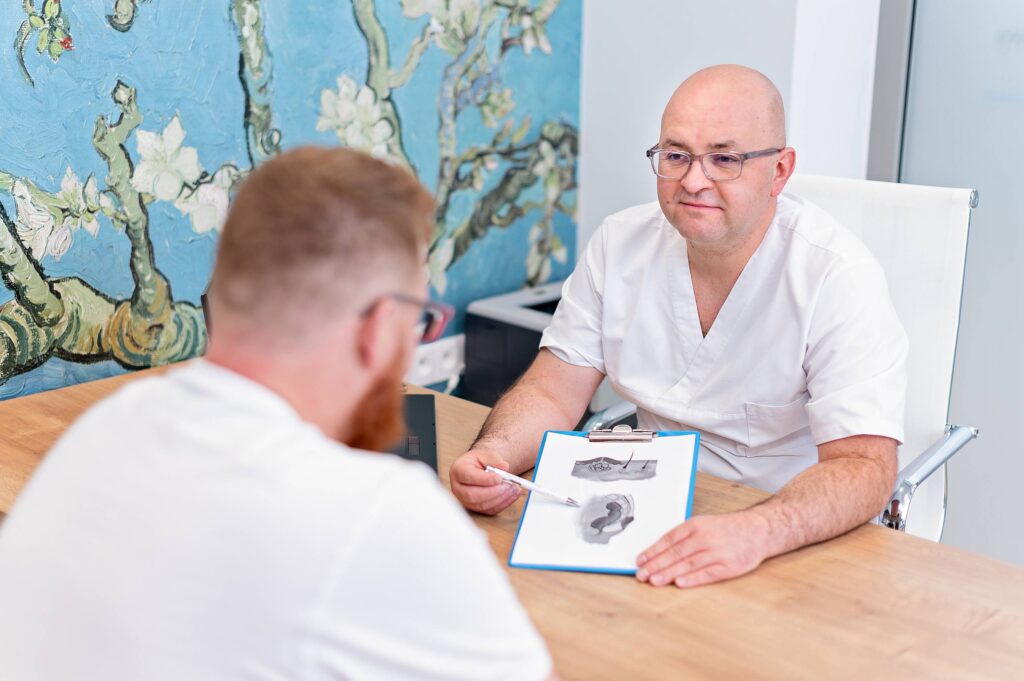Alternative methods of treating pilonidal cyst
Numerous surgical and conservative methods are available for treating pilonidal disease. Despite the widespread use of some of these techniques, their outcomes in terms of wound healing and long-term effectiveness remain unsatisfactory.
Incision and Drainage of an Abscess
An abscess is often the initial clinical symptom of a pilonidal cyst, making incision and drainage a common foundation for treating the acute phase of the disease and enabling further therapeutic intervention. The goal of this procedure is to evacuate the pus accumulated under the skin, leading to the alleviation of infection symptoms and a reduction in inflammation.
Simple Excision with Secondary Wound Healing
The most commonly performed procedure worldwide is the simple excision of a pilonidal cyst with the wound left open to heal by secondary intention. This method is so widespread that many patients associate it with “surgical treatment” and immediately seek alternative approaches (e.g., laser methods). Despite its popularity, the treatment outcomes are disappointing—post-surgery, a deep, extensive wound remains, with healing times ranging from several months to, in extreme cases, years. Such a prolonged period of leaving an open wound in close proximity to the anus leads to recurrent purulent infections and secondary skin damage in the area due to inflammation and persistent bloody-purulent discharge. Although this method has a moderate success rate (approximately 50%), its lengthy recovery time and significant care burden render it outdated and not recommended as a routine therapeutic option under modern standards.
Simple Excision with Wound Closure
Another approach to treating pilonidal cysts involves simple excision followed by wound closure, which aims to shorten healing time and enable a quicker return to daily activities compared to leaving the wound open. While the procedure is technically straightforward, its long-term effectiveness raises serious concerns—the wound may initially heal properly but typically reopens secondarily, leading to infections requiring prolonged and specialized care. Studies have shown that the recurrence and failure rate exceeds 65%, making this method less favorable in terms of lasting therapeutic results.
Marsupialization of a Pilonidal Cyst
Marsupialization involves the radical excision of the diseased pilonidal cyst, followed by suturing the wound edges to its base, typically in the sacral area, and leaving it to heal by secondary intention. The aim of this approach is to permanently remove the disease focus and prevent recurrence by creating a stable, open defect. While this method may lead to a definitive cure, its significant drawback is the formation of a permanent, deep depression in the sacral area, which patients often find cosmetically unappealing and causes discomfort when sitting due to the lack of natural fat padding. In light of current knowledge and available alternatives, this procedure lacks clinical justification and should not be used routinely.
Pit Picking
The surgical technique known as pit picking involves making small incisions along the midline, in the area of skin fistulas penetrating the subcutaneous tissue. An additional lateral incision allows for the removal of hair and necrotic-inflammatory material from the pilonidal sinus. Recommended by Dr. Bascom for early and limited cases of pilonidal disease, this minimally invasive method can be performed on an outpatient basis. Despite its low invasiveness, its effectiveness remains limited—particularly in patients with a deep gluteal cleft, where the risk of disease recurrence is significant. For this reason, pit picking is not recommended as a first-line method for patients seeking a permanent cure.
Fibrin Glue
One of the newer techniques for treating pilonidal disease, described in medical literature, involves mechanical cleansing (curettage) of fistulas and the pilonidal sinus, followed by filling them with fibrin glue. While this procedure shows some therapeutic potential, current data on its effectiveness are limited and inconsistent. A key limitation is the lack of intervention in the anatomical depth of the gluteal cleft, which contributes to disease recurrence.
Excision with Skin Grafting
Skin grafting in the treatment of pilonidal disease is a rarely used but viable therapeutic option, typically reserved for recurrent cases or extensive defects following the excision of diseased tissue. The procedure involves removing the area affected by inflammation and covering the wound with a skin graft harvested from another part of the body. Unlike most standard procedures performed on an outpatient basis, this method may require hospitalization, patient immobilization, and intensive wound care to ensure proper graft acceptance.
Flap Procedures – Z-Plasty, V-Y Advancement Flap, and Limberg Flap
Various surgical techniques using skin-subcutaneous flaps, such as Z-plasty, V-Y advancement flap, and the rhomboid Limberg flap, have been developed to cover defects after the excision of pilonidal disease foci and to flatten the gluteal cleft, theoretically reducing the risk of recurrence. These procedures often result in an unsatisfactory cosmetic outcome, and achieving a lasting flattening of the gluteal cleft requires an aggressive and precise surgical approach. Based on available data, none of the flap procedures demonstrate a clear advantage in terms of long-term effectiveness for treating pilonidal disease.
Cleft-Lift Procedure for the Intergluteal Cleft
The Cleft-Lift procedure for the intergluteal cleft (also known as Bascom II, after its developer) is a highly successful modification of the Karydakis method. It involves the removal of the pilonidal cyst along with the flattening of the intergluteal cleft. This method best fulfills the medical objectives of treatment while providing a favorable aesthetic outcome.
Find out about the treatment costs
We know the importance of the recovery period as well as the patients’ sense of security and awareness that the recovery is going well as planned, which is why the follow-up visits throughout the entire postoperative healing process is included in the procedure price.
